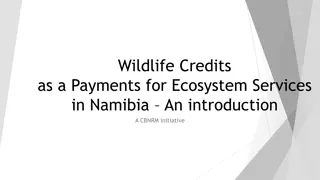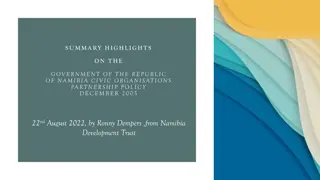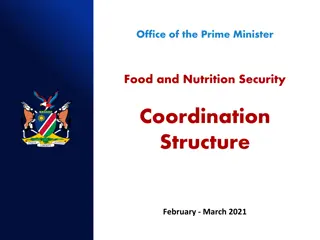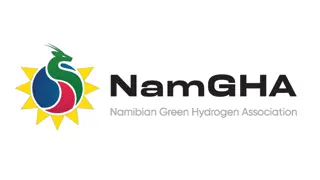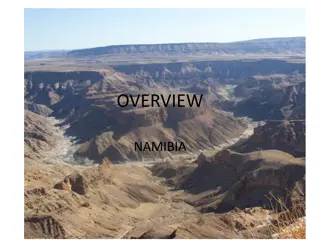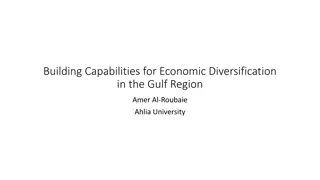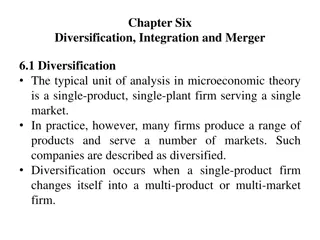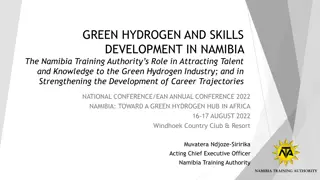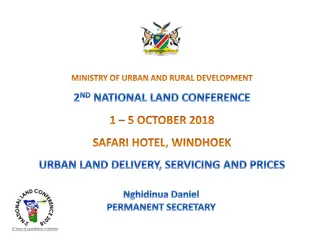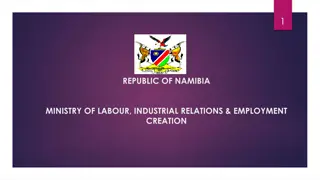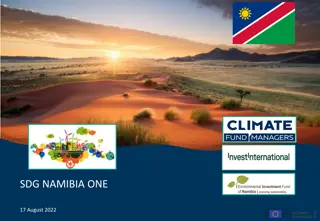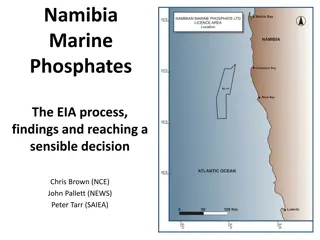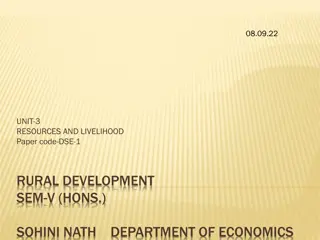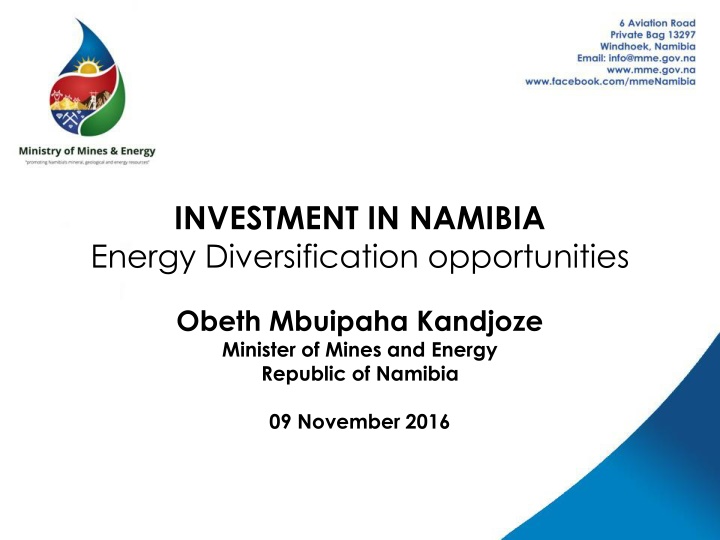
Investment Opportunities in Namibia Energy Diversification
Namibia presents investment opportunities for energy diversification, aiming to increase local electricity generation capacity and rural electrification rates by 2020. The Ministry of Mines and Energy oversees the country's rich mineral and energy resources to drive socio-economic development. Namibia heavily relies on energy imports, highlighting the need for sustainable solutions and development in renewable energy sources like solar, wind, geothermal, and more.
Download Presentation

Please find below an Image/Link to download the presentation.
The content on the website is provided AS IS for your information and personal use only. It may not be sold, licensed, or shared on other websites without obtaining consent from the author. If you encounter any issues during the download, it is possible that the publisher has removed the file from their server.
You are allowed to download the files provided on this website for personal or commercial use, subject to the condition that they are used lawfully. All files are the property of their respective owners.
The content on the website is provided AS IS for your information and personal use only. It may not be sold, licensed, or shared on other websites without obtaining consent from the author.
E N D
Presentation Transcript
INVESTMENT IN NAMIBIA Energy Diversification opportunities Obeth Mbuipaha Kandjoze Minister of Mines and Energy Republic of Namibia 09 November 2016
Outline Mandate of the Ministry of Mines and Energy Harambee Goal and outcomes [HPP11] Overview Primary Energy Use Electricity Supply Industry Market Model Policies under review Legislations under review Investment opportunities Electricity Tariffs Project Pipelines Challenges and Opportunities
Mandate of the Ministry of Mines Energy The Ministry of Mines and Energy is constitutionally established to take custody of Namibia s rich endowment of mineral and energy resources and create an environment in which the mineral, energy and geological resources contribute to the country s socio-economic development
Legal Framework Petroleum Products and Energy Act No.13 of 1990, and amendments White Paper on Energy Policy, 1998 Under review Electricity Act 4, 2007 Under review Rural Electrification Master Plan, 2000, 2005 and 2010 Off-grid Energisation Master Plan, 2007 National Integrated Resource Plan (NIRP) 2013, - Under review IPP framework, 2005 Under review
Harambee Goal and Outcomes #11 HPP11 - The desired outcome/s with regard to electricity supply during the Harambee period will be There will be zero national load shedding during the Harambee period Increase local electricity generation capacity from 400MW to 600MW by 2020 Provisions of electricity to all schools and health facilities by 2020 Increase in the rural electrification rate from 12 percent to 50 percent by 2020
Overview Primary Energy Use Namibia enjoys one of the highest solar irradiance levels in the world, thus we are the destination of choice for renewable energy projects, particularly solar photovoltaic, concentrated solar power (CSP) and solar thermal. Other significant primary energy resources include, good wind regimes prevalent at the coastal areas, Natural Gas, Geothermal, Wave, Tidal and Uranium. However the country is fully dependent on the import of fossil fuels. Up to 60% of electricity is imported from neighbouring countries. Breakdown of primary energy by type: Fossil fuels, (Petroleum and Diesel) - 58% Electricity, (Hydro, Solar PV, Diesel, Coal and Imports) - 20% Biomass, (Wood and Charcoal) - 20% Coal, 2% Perpetual reliance on energy imports is not a sustainable option for Namibia Any shortage of any supply will have serious negative impact on the national development aspirations. Namibia needs considerable investments in the indigenous sources to reduce exposure .
Snapshot of the Energy Sector ESI Focus
Africa is an attractive investment partner but its full opportunity is yet to be unlocked and its progress remains obstructed by the lack of electricity Earth at Night, NASA Satellite Photo, November 27, 2000
Namibias Electricity Existing Supply Ruacana Hydro 345 MW Installed capacity ~ 480 MW HopSol 5 MW Omburu 4.5 MW Interconnector ~ 600 MW HopSol 5 MW Osona 5 MW Max Demand in 2015 ~ 600 MW Paratus HFO 12 MW Van Eck Coal 81 MW Anixas HFO 22 MW Transmission network: ~11 000 km Distribution network: ~22 000 km Imports: > 60%
Market Model Single Buyer Market Model The single buyer electricity market model was adopted by Cabinet in 2000, and is current applicable model for the country, NamPower through a trading license is the Single Buyer. Modified Single Buyer Market Model (Proposed) To accommodate the ever changing environment, a modified single buyer model is being discussed to allow IPP to sell directly to off takers other than the Single Buyer; i.e. REDs, Mines, and other Transmission Large Power Users While the Electricity Bill of 2016 lays the groundwork for an updated market model, the impacts of the proposed model remain uncertain, especially in regard to its economic and institutional implications. The electricity market model therefore requires additional work before it is ready for implementation. The process of reviewing and updating the market model will be finalised by the last quarter of 2017.
Policies under Review and Development - National Energy Policy - Review of the current White Paper on Energy Policy of 1998 - To achieve long-term economic empowerment, sustainable growth and national development - Stakeholder consultations on-going - Completion Target March 2017 - Renewable Energy Policy - To promote development of Namibia s RE resources - Development of the RE Policy to deal with the role of RE in the electricity sector, - Stakeholder consultation completed - Draft submitted to Minister for consideration
Policies under Review and Development - Independent Power Producers Policy - Address security of supply in the country through private sector investment - Review of the current IPP investors Framework - Develop an IPP Policy to guide and promote IPP investments - Completion target, March 2017 - National Integrated Resource Plan (NIRP) Planning parameter for the country s electricity generation capacity for the next 20 years Diversification of energy mix, including all energy resources To be submitted to Cabinet before end of 2016
Legislations under Review and Development - Namibia Energy Regulatory Authority Bill (NERA) - To establish Namibia Energy Regulator for; electricity, downstream gas and petroleum, renewable energy, energy efficiency and the creation on an energy tribunal - Completion target, March 2017 Electricity Bill - To update the current Electricity Act No.4 of 2007, to reflect developments in the industry, and to improve enforcement powers, - Completion target, March 2017 Gas Bill - To regulate downstream gas, transportation, marketing, storage and related matters - Completion target, December 2017 - -
Electricity Supply Industry - Investment Opportunities
Opportunities in the sector Our Offer . - The Namibia Electricity Supply Industry offers an attractive investment climate, backed by a politically stable environment, clear defined energy policies, highly competitive regulatory regime offering cost reflective tariffs and other essential regulatory oversight services. Opportunities in the Sector include: - Generation options as reflected in the National Integrated Resource Plan (NIRP), - Transmission Projects as per NamPower Transmission Master Plan, - Distribution Projects as identified by the Regional Electricity Distributors (REDs), - Off Grid Electrification Projects and Grid Electrification Projects as proposed by REDs and as recommended in the Project on Support Mechanisms to Improve the Electrification of Households in Urban and Rural Namibia. -
Electricity Tariffs - - Electricity tariffs are cost reflective as formally adopted by Cabinet. While this has been successful in ensuring the viability of licensees in continuous supply of electricity, it has also created major upheavals, most notably as a result of the impact on the affordability of electricity. Electricity Tariffs are set and approved by the Electricity Control Board as per the Electricity Act. Investors are allowed a regulated return on the investment determined by the Regulator. - -
Projects Pipeline and opportunities - Interim REFIT Programme: 70MW (licenses awarded) - 14 Generation licenses for 5 MW RE plants each - Procurement and PPA complete - Two Projects commissioned - HopSol (Grootfontein and InnoSun Osona) - 12 in different stages of development - Commission Target June 2017 - Solar PV Tender: 37MW at Mariental - Tender under adjudication - Commission Target December 2017
Projects Pipeline and opportunities - Unsolicited Projects (licenses awarded) - 20MW Solar PV (GreeNam) - Commission Target End 2017 - 44 MW Wind (Diaz) - Commission Target Early 2018 - Biomass Harvesting for Electricity Generation (20MW 30MW) Planning stage, investment decision late 2017 To be procured on open public tender
Projects Pipeline and opportunities - Concentrated Solar Power (CSP) with Thermal Energy Storage (100MW 150MW) CSP with thermal storage On a Public Private Partnership concept Tender to be out early 2017 - Kudu Gas and Power Development (884MW) - Opportunity for public private sector partnerships (PPPs) - Upstream - Divesting of NamCor interest - Downstream - Equity in the Kudu Power
Projects Pipeline and opportunities - Hydro Power - Baynes (600MW) - Lower Orange Hydro (80MW 120MW) - To be procured on open public tender - MiniGrids / Off grid Electrification - Public Private Partnership arrangements for mini grids and off grid electrifications - MME is keen to discuss proposals with the investors
NEW GENERATION CAPACITIES and Opportunities 2016 - 2026 Biomass Plants 3x10 MW Paratus Upgrade - 60 MW Arandis CSP Plant Remaining REFIT NamPower PV 37 MW 100-150 MW 97 MW 90 MW Commissioning Aug 2021 Commissioning Dec 2017 Commissioning Jun 2020 1153 MW Dec 2020 Commissioning Dec 2026 Commissioning Jun 2016 Commissioned Dec 2018 Commissioning 442 MW 300 MW 10 MW 64 MW Kudu Project 884MW 1st REFIT Hopsol - 5MW 2nd REFIT Innosun - 5MW Diaz Wind 44 MW GreeNam PV 20MW Baynes Hydro Project 300 MW 640 MW HPP
Final Thoughts While recognizing the remarkable successes the Government of Namibia has recorded in sustainably financing critical service sectors such as Health, Education and Infrastructure Development through the Fiscus, global market forces and other factors have continued to negatively impact on state revenue sources. It is against this background that Namibia wishes to engage Development Partners and Investors to mobilize resources to finance projects for the energy sector, which is a vital engine for overall economic growth. The Ministry of Mines and Energy is committed to Align the Policies and Legislations to address the current challenges Increase amount of local generated electricity with focus on base load and mid merit plants Increase access to electricity Increase private investment in the energy industry
Conclusion When citizens are without access to electricity, they are by implication, excluded from actively participating in national economic development activities. This is contrary to the Harambee Prosperity Plan principle of inclusivity of all citizens and also not in line with the commitment to industrialize Namibia as articulated in vision 2030. All the efforts to electrify, improve access, and address the issue of security of supply, are meant to compliment the initiatives also articulated in the Government Harambee Prosperity Plan for the energy sector. I urge the investors to get into contact with the Electricity Control Board, NamPower for detailed information on specific projects. It is our commitment to engaging development partners to mobilize resources to ensure success of these important projects.

